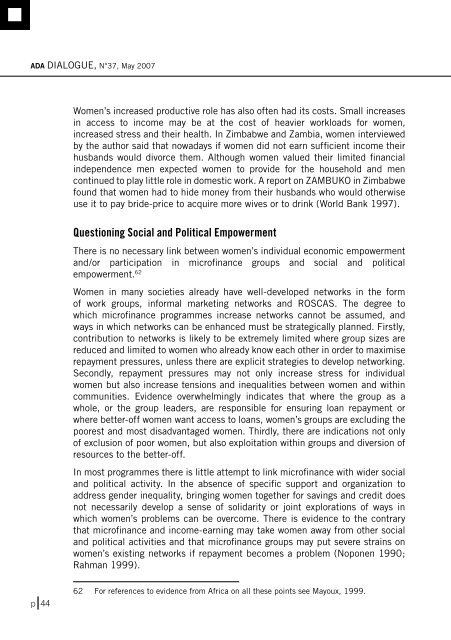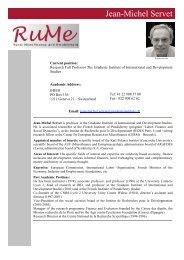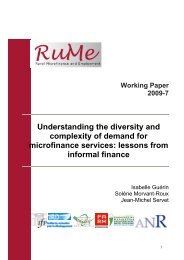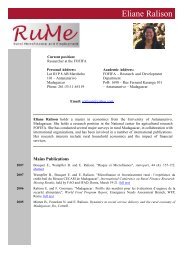Dialogue Dialogue
Microfinance and Gender: New Contributions to an Old Issue - ADA
Microfinance and Gender: New Contributions to an Old Issue - ADA
- No tags were found...
You also want an ePaper? Increase the reach of your titles
YUMPU automatically turns print PDFs into web optimized ePapers that Google loves.
ADA DIALOGUE, N°37, May 2007<br />
Women’s increased productive role has also often had its costs. Small increases<br />
in access to income may be at the cost of heavier workloads for women,<br />
increased stress and their health. In Zimbabwe and Zambia, women interviewed<br />
by the author said that nowadays if women did not earn sufficient income their<br />
husbands would divorce them. Although women valued their limited financial<br />
independence men expected women to provide for the household and men<br />
continued to play little role in domestic work. A report on ZAMBUKO in Zimbabwe<br />
found that women had to hide money from their husbands who would otherwise<br />
use it to pay bride-price to acquire more wives or to drink (World Bank 1997).<br />
Questioning Social and Political Empowerment<br />
There is no necessary link between women’s individual economic empowerment<br />
and/or participation in microfinance groups and social and political<br />
empowerment. 62<br />
Women in many societies already have well-developed networks in the form<br />
of work groups, informal marketing networks and ROSCAS. The degree to<br />
which microfinance programmes increase networks cannot be assumed, and<br />
ways in which networks can be enhanced must be strategically planned. Firstly,<br />
contribution to networks is likely to be extremely limited where group sizes are<br />
reduced and limited to women who already know each other in order to maximise<br />
repayment pressures, unless there are explicit strategies to develop networking.<br />
Secondly, repayment pressures may not only increase stress for individual<br />
women but also increase tensions and inequalities between women and within<br />
communities. Evidence overwhelmingly indicates that where the group as a<br />
whole, or the group leaders, are responsible for ensuring loan repayment or<br />
where better-off women want access to loans, women’s groups are excluding the<br />
poorest and most disadvantaged women. Thirdly, there are indications not only<br />
of exclusion of poor women, but also exploitation within groups and diversion of<br />
resources to the better-off.<br />
In most programmes there is little attempt to link microfinance with wider social<br />
and political activity. In the absence of specific support and organization to<br />
address gender inequality, bringing women together for savings and credit does<br />
not necessarily develop a sense of solidarity or joint explorations of ways in<br />
which women’s problems can be overcome. There is evidence to the contrary<br />
that microfinance and income-earning may take women away from other social<br />
and political activities and that microfinance groups may put severe strains on<br />
women’s existing networks if repayment becomes a problem (Noponen 1990;<br />
Rahman 1999).<br />
p I 44<br />
62 For references to evidence from Africa on all these points see Mayoux, 1999.





